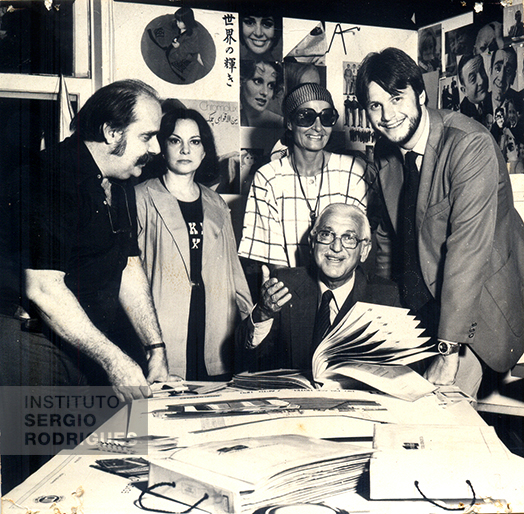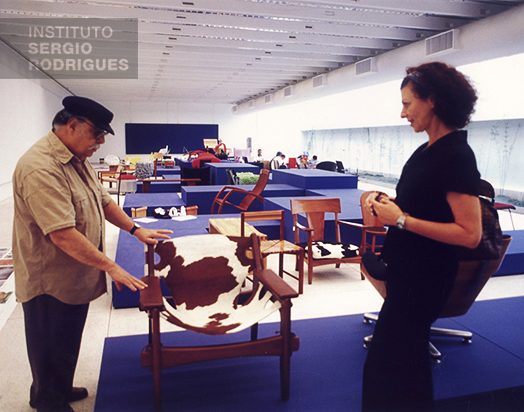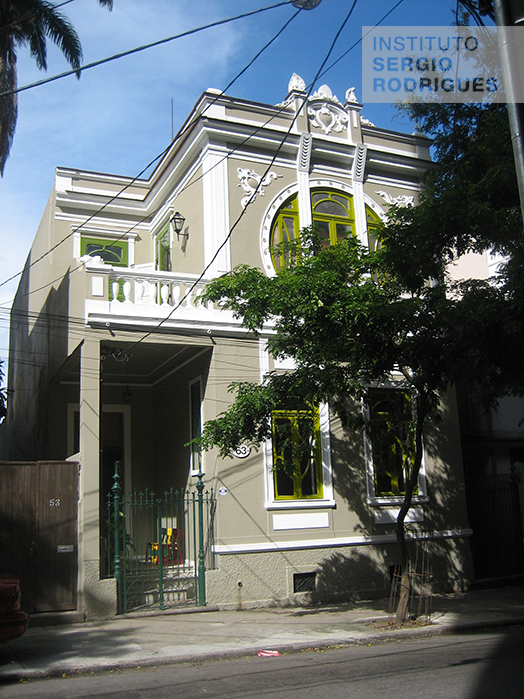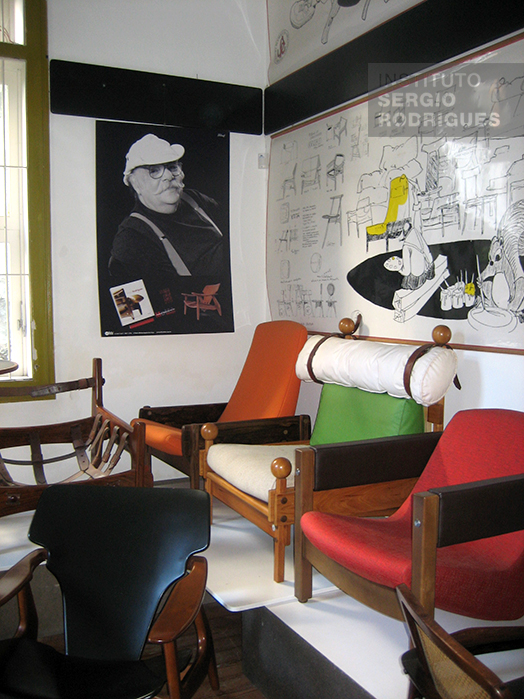Vera Beatriz went looking for producers to relaunch Sergio's furniture
Vera Beatriz went looking for producers to relaunch Sergio’s furniture
When he left Oca, Sergio lost the rights to his work, which belonged to the company. Upon leaving, he left all his assets. He had never registered the furniture he created in his name. Officially, they were Oca’s furniture, not Sergio Rodrigues’. Years later, in the 1990s, Oca was sold to an American company. They only sold imported furniture there, but kept the name. The Americans did not appreciate Sergio’s furniture. They went on to buy and resell furniture. When they decided to sell Oca, they phoned Sergio and, luckily, Vera Beatriz answered. They wanted to sell Sergio his own projects. “How can Sergio buy his own drawings? They are his intellectual property, we will sue you,” said Vera. The Americans eventually closed the store, left Brazil, and gave Sergio’s designs back to him.
After she decided to take Sergio’s business over, Vera Beatriz organized his entire personal and professional life. When they got married, Sergio worked as an architecture, and no longer dealt with furniture production as much. Vera knew he had to get back to making his designs and resume furniture creation and production. She always found it easy to interact and negotiate with people. Determined, sweet, but firm, she was ready to relaunch Sergio and his creations.
That was when Vera began to endeavor to revive Sergio’s furniture. They traveled to the South in pursuit of potential manufacturers, offered at factories, went to São Paulo, Bento Gonçalves. “In those days, no one could care less about design. Factory owners wanted to get rich fast and sale furniture that was easy to make, which they could put in the machine and sell. They thought it was all beautiful, but very expensive and very difficult to manufacture because the furniture was all semi-artisanal.”
When a piece of Sergio’s furniture came in, manufacturers were excited, but then thought it would not be feasible. “Entrepreneurs in Brazil new nothing about design,” said Vera Beatriz. “That was between 1975 and 1980.”
While Vera was trying to find a manufacturer to make Sergio’s furniture, two exhibitions of his work marked an era and brought Sergio back to the mainstream. One was at the Rio de Janeiro Museum of Modern Art, in 1991. MAM granted a wonderful lounge and Sergio and Vera, without money to make the exhibition, had to use imagination and creativity both. They had to buy the practicable pieces to exhibit the furniture and pay the entire assembly. Vera Beatriz had already invested in Sergio’s furniture project everything she had and what she had inherited from her mother. They then boldly asked Kati de Almeida Braga, from the Icatu insurance company, for help. It was the saving solution. Kati agreed and her company funded part of the exhibition, which was a big hit. The exhibition showed the date on which the furniture had been created, in chronological order, and there were pictures of Sergio at all those times, like a timeline marking his career. Sergio’s friend Adolfo Bloch ordered posters and flyers with the program and description of the exhibition, which was open for visitation a long time.
In 1999, another exhibition at the Rio Design mall, in Leblon, caught the attention of a Curitiba businesswoman, Gisele Schwartsburd. Soon after visiting the show, Gisele contacted Sergio’s office and said she wanted to pay him a visit for a chat. She liked his furniture and wanted to know why he did not make it anymore. Upon arriving, she said her father had a furniture factory in Curitiba, and she was his representative in Rio. Vera Beatriz had never met her before. “The only reference we had of her was that she was a friend of the son of a friend of mine, of Sion,” said Vera.
– I want to relaunch Sergio’s furniture.
– But can you afford it? – asked Vera.
– Not a penny. But I have an apartment in Vidigal. I will sell it and relaunch Sergio’s furniture.
Vera Beatriz accepted immediately, believing in her by intuition. She was tired of peddling his products from factory to factory to no avail, and saw that Gisele truly realized and believed in the value and quality of Sergio’s furniture.
Shortly after that, in 2000, Icatu Seguros funded a beautiful book about Sergio, organized by Soraya Cals, with copy by Maria Cecília Loschiavo dos Santos, an introduction by Millôr Fernandes, and presented by Kati Almeida Braga. The book was distributed to all his customers. Since there was also an English translation of the book, Icatu sent it to its customers abroad. The book launch was held at the studio of dealer Jean Bogisch. “It was a year full of light for us.”
Beatriz Vera remembers the time well: Until then, Sergio’s furniture was being made by two exceptional carpenters, Joaquim Milhazes and Romualdo Falcão, the best in Rio, Vera Beatriz guaranteed. However, in 2000, Gisele opened LinBrasil, a company to make only his pieces. “It was a turnaround. Because of the book, everyone wanted Sergio’s new furniture. Then, Gisele started to revive the furniture, at first with a little difficulty, until the factory got the manufacturing right and made the furniture properly.”
“Our furniture was built very well, we sold to our customers, but they were handmade. They were not sold in a store. Sergio did a lot of interior architecture and would put his furniture in the project. He drew furniture for customers and then would not produce those pieces any more. We made a little off of the furniture, because we made nothing at all with architecture. The designs were very thorough, and Sergio changed details all the time. But we needed more income.” That was when Vera decided to open a furniture store and a place to house the Sergio Rodrigues Arquitetura Ltda. architecture firm at the house they had bought on Conde de Irajá street, 63, in Botafogo. And they started making a living off of that.
In 2004, Gisele changed factories and started making furniture with excellence. Three years later, in 2007, Sergio’s furniture appreciated a lot after being exhibited at the Trade Show in Milan, Italy, promoted by LinBrasil. Fernando Mendes de Almeida also started making them with extreme precision.
The contract with Gisele was initially for a ten-year term. During that time, no one else could make the furniture and she was the only person who could sell Sergio’s productions. “But I would do anything because no one wanted to make it. I had noted that Sergio was going to die without any recognition.”
When the contract was renewed with Sergio, the line was split in two, with the exclusive lists going to LinBrasil and to Atelier Fernando Mendes. Today, Butzke manufactures the garden line under assignment of LinBrasil, and Etel Carmona was granted the right to manufacture the Adolpho desk and small chair.
Today, Vera has a contract with Gisele and another one with Fernando. LinBrasil kept the furniture she already made, the most iconic, and classics like the Mole and Kilin armchairs, the Oscar chair, and the Mocho stool. Fernando kept the special furniture, which had not yet been released.
Today, Vera Beatriz is sure things would have turned out very bad for Sergio had he not married her. “Sergio was never rich, but I was able to put his life on track. He earned money with decor, but was not organized, it was all chaotic, he always lost money. I went to take care of him because his financial life was a total wreck. No factory wanted anything to do with Sergio. Today, they are all desperate after Sergio and Gisele, who decided to launch his furniture, and was very successful.”
Sergio got only 2 percent of sales proceeds from the few factories making his furniture. With Gisele, this was increased to 10 percent. “My goal was to add value to his name. He was a genius. He often woke up at night and asked for a piece of paper to draw a piece of furniture on. I wanted him to get this recognition before he died. And we managed to do that.”
Dolly Michailovsky, who worked with Sergio for many years, since the Oca days, believes he owes 40 percent of his success to Vera Beatriz. “She never gave up. People often preferred what they saw in foreign magazines. Now it is his furniture that is featured in those magazines.”

From left to right, Sergio Rodrigues, Vera Beatriz and Dolly Soares, at Sergio's studio, in Botafogo - Rio de Janeiro, 1980.

Sergio Rodrigues demonstrating the Leve Kilin armchair to Gisele Pereira Schwartsbud (owner of Lin Brazil), in the 1990s.

Façade of Sergio Rodrigues' studio, Botafogo - Rio de Janeiro, 2000s.

Interior of Sergio Rodrigues' studio, Botafogo - Rio de Janeiro, 2000s.
